License
Attribution-ShareAlike 4.0 International
=======================================================================
Creative Commons Corporation ("Creative Commons") is not a law firm and
does not provide legal services or legal advice. Distribution of
Creative Commons public licenses does not create a lawyer-client or
other relationship. Creative Commons makes its licenses and related
information available on an "as-is" basis. Creative Commons gives no
warranties regarding its licenses, any material licensed under their
terms and conditions, or any related information. Creative Commons
disclaims all liability for damages resulting from their use to the
fullest extent possible.
Using Creative Commons Public Licenses
Creative Commons public licenses provide a standard set of terms and
conditions that creators and other rights holders may use to share
original works of authorship and other material subject to copyright
and certain other rights specified in the public license below. The
following considerations are for informational purposes only, are not
exhaustive, and do not form part of our licenses.
Considerations for licensors: Our public licenses are
intended for use by those authorized to give the public
permission to use material in ways otherwise restricted by
copyright and certain other rights. Our licenses are
irrevocable. Licensors should read and understand the terms
and conditions of the license they choose before applying it.
Licensors should also secure all rights necessary before
applying our licenses so that the public can reuse the
material as expected. Licensors should clearly mark any
material not subject to the license. This includes other CC-
licensed material, or material used under an exception or
limitation to copyright. More considerations for licensors:
wiki.creativecommons.org/Considerations_for_licensors
Considerations for the public: By using one of our public
licenses, a licensor grants the public permission to use the
licensed material under specified terms and conditions. If
the licensor's permission is not necessary for any reason--for
example, because of any applicable exception or limitation to
copyright--then that use is not regulated by the license. Our
licenses grant only permissions under copyright and certain
other rights that a licensor has authority to grant. Use of
the licensed material may still be restricted for other
reasons, including because others have copyright or other
rights in the material. A licensor may make special requests,
such as asking that all changes be marked or described.
Although not required by our licenses, you are encouraged to
respect those requests where reasonable. More considerations
for the public:
wiki.creativecommons.org/Considerations_for_licensees
=======================================================================
Creative Commons Attribution-ShareAlike 4.0 International Public
License
By exercising the Licensed Rights (defined below), You accept and agree
to be bound by the terms and conditions of this Creative Commons
Attribution-ShareAlike 4.0 International Public License ("Public
License"). To the extent this Public License may be interpreted as a
contract, You are granted the Licensed Rights in consideration of Your
acceptance of these terms and conditions, and the Licensor grants You
such rights in consideration of benefits the Licensor receives from
making the Licensed Material available under these terms and
conditions.
Section 1 -- Definitions.
a. Adapted Material means material subject to Copyright and Similar
Rights that is derived from or based upon the Licensed Material
and in which the Licensed Material is translated, altered,
arranged, transformed, or otherwise modified in a manner requiring
permission under the Copyright and Similar Rights held by the
Licensor. For purposes of this Public License, where the Licensed
Material is a musical work, performance, or sound recording,
Adapted Material is always produced where the Licensed Material is
synched in timed relation with a moving image.
b. Adapter's License means the license You apply to Your Copyright
and Similar Rights in Your contributions to Adapted Material in
accordance with the terms and conditions of this Public License.
c. BY-SA Compatible License means a license listed at
creativecommons.org/compatiblelicenses, approved by Creative
Commons as essentially the equivalent of this Public License.
d. Copyright and Similar Rights means copyright and/or similar rights
closely related to copyright including, without limitation,
performance, broadcast, sound recording, and Sui Generis Database
Rights, without regard to how the rights are labeled or
categorized. For purposes of this Public License, the rights
specified in Section 2(b)(1)-(2) are not Copyright and Similar
Rights.
e. Effective Technological Measures means those measures that, in the
absence of proper authority, may not be circumvented under laws
fulfilling obligations under Article 11 of the WIPO Copyright
Treaty adopted on December 20, 1996, and/or similar international
agreements.
f. Exceptions and Limitations means fair use, fair dealing, and/or
any other exception or limitation to Copyright and Similar Rights
that applies to Your use of the Licensed Material.
g. License Elements means the license attributes listed in the name
of a Creative Commons Public License. The License Elements of this
Public License are Attribution and ShareAlike.
h. Licensed Material means the artistic or literary work, database,
or other material to which the Licensor applied this Public
License.
i. Licensed Rights means the rights granted to You subject to the
terms and conditions of this Public License, which are limited to
all Copyright and Similar Rights that apply to Your use of the
Licensed Material and that the Licensor has authority to license.
j. Licensor means the individual(s) or entity(ies) granting rights
under this Public License.
k. Share means to provide material to the public by any means or
process that requires permission under the Licensed Rights, such
as reproduction, public display, public performance, distribution,
dissemination, communication, or importation, and to make material
available to the public including in ways that members of the
public may access the material from a place and at a time
individually chosen by them.
l. Sui Generis Database Rights means rights other than copyright
resulting from Directive 96/9/EC of the European Parliament and of
the Council of 11 March 1996 on the legal protection of databases,
as amended and/or succeeded, as well as other essentially
equivalent rights anywhere in the world.
m. You means the individual or entity exercising the Licensed Rights
under this Public License. Your has a corresponding meaning.
Section 2 -- Scope.
a. License grant.
1. Subject to the terms and conditions of this Public License,
the Licensor hereby grants You a worldwide, royalty-free,
non-sublicensable, non-exclusive, irrevocable license to
exercise the Licensed Rights in the Licensed Material to:
a. reproduce and Share the Licensed Material, in whole or
in part; and
b. produce, reproduce, and Share Adapted Material.
2. Exceptions and Limitations. For the avoidance of doubt, where
Exceptions and Limitations apply to Your use, this Public
License does not apply, and You do not need to comply with
its terms and conditions.
3. Term. The term of this Public License is specified in Section
6(a).
4. Media and formats; technical modifications allowed. The
Licensor authorizes You to exercise the Licensed Rights in
all media and formats whether now known or hereafter created,
and to make technical modifications necessary to do so. The
Licensor waives and/or agrees not to assert any right or
authority to forbid You from making technical modifications
necessary to exercise the Licensed Rights, including
technical modifications necessary to circumvent Effective
Technological Measures. For purposes of this Public License,
simply making modifications authorized by this Section 2(a)
(4) never produces Adapted Material.
5. Downstream recipients.
a. Offer from the Licensor -- Licensed Material. Every
recipient of the Licensed Material automatically
receives an offer from the Licensor to exercise the
Licensed Rights under the terms and conditions of this
Public License.
b. Additional offer from the Licensor -- Adapted Material.
Every recipient of Adapted Material from You
automatically receives an offer from the Licensor to
exercise the Licensed Rights in the Adapted Material
under the conditions of the Adapter's License You apply.
c. No downstream restrictions. You may not offer or impose
any additional or different terms or conditions on, or
apply any Effective Technological Measures to, the
Licensed Material if doing so restricts exercise of the
Licensed Rights by any recipient of the Licensed
Material.
6. No endorsement. Nothing in this Public License constitutes or
may be construed as permission to assert or imply that You
are, or that Your use of the Licensed Material is, connected
with, or sponsored, endorsed, or granted official status by,
the Licensor or others designated to receive attribution as
provided in Section 3(a)(1)(A)(i).
b. Other rights.
1. Moral rights, such as the right of integrity, are not
licensed under this Public License, nor are publicity,
privacy, and/or other similar personality rights; however, to
the extent possible, the Licensor waives and/or agrees not to
assert any such rights held by the Licensor to the limited
extent necessary to allow You to exercise the Licensed
Rights, but not otherwise.
2. Patent and trademark rights are not licensed under this
Public License.
3. To the extent possible, the Licensor waives any right to
collect royalties from You for the exercise of the Licensed
Rights, whether directly or through a collecting society
under any voluntary or waivable statutory or compulsory
licensing scheme. In all other cases the Licensor expressly
reserves any right to collect such royalties.
Section 3 -- License Conditions.
Your exercise of the Licensed Rights is expressly made subject to the
following conditions.
a. Attribution.
1. If You Share the Licensed Material (including in modified
form), You must:
a. retain the following if it is supplied by the Licensor
with the Licensed Material:
i. identification of the creator(s) of the Licensed
Material and any others designated to receive
attribution, in any reasonable manner requested by
the Licensor (including by pseudonym if
designated);
ii. a copyright notice;
iii. a notice that refers to this Public License;
iv. a notice that refers to the disclaimer of
warranties;
v. a URI or hyperlink to the Licensed Material to the
extent reasonably practicable;
b. indicate if You modified the Licensed Material and
retain an indication of any previous modifications; and
c. indicate the Licensed Material is licensed under this
Public License, and include the text of, or the URI or
hyperlink to, this Public License.
2. You may satisfy the conditions in Section 3(a)(1) in any
reasonable manner based on the medium, means, and context in
which You Share the Licensed Material. For example, it may be
reasonable to satisfy the conditions by providing a URI or
hyperlink to a resource that includes the required
information.
3. If requested by the Licensor, You must remove any of the
information required by Section 3(a)(1)(A) to the extent
reasonably practicable.
b. ShareAlike.
In addition to the conditions in Section 3(a), if You Share
Adapted Material You produce, the following conditions also apply.
1. The Adapter's License You apply must be a Creative Commons
license with the same License Elements, this version or
later, or a BY-SA Compatible License.
2. You must include the text of, or the URI or hyperlink to, the
Adapter's License You apply. You may satisfy this condition
in any reasonable manner based on the medium, means, and
context in which You Share Adapted Material.
3. You may not offer or impose any additional or different terms
or conditions on, or apply any Effective Technological
Measures to, Adapted Material that restrict exercise of the
rights granted under the Adapter's License You apply.
Section 4 -- Sui Generis Database Rights.
Where the Licensed Rights include Sui Generis Database Rights that
apply to Your use of the Licensed Material:
a. for the avoidance of doubt, Section 2(a)(1) grants You the right
to extract, reuse, reproduce, and Share all or a substantial
portion of the contents of the database;
b. if You include all or a substantial portion of the database
contents in a database in which You have Sui Generis Database
Rights, then the database in which You have Sui Generis Database
Rights (but not its individual contents) is Adapted Material,
including for purposes of Section 3(b); and
c. You must comply with the conditions in Section 3(a) if You Share
all or a substantial portion of the contents of the database.
For the avoidance of doubt, this Section 4 supplements and does not
replace Your obligations under this Public License where the Licensed
Rights include other Copyright and Similar Rights.
Section 5 -- Disclaimer of Warranties and Limitation of Liability.
a. UNLESS OTHERWISE SEPARATELY UNDERTAKEN BY THE LICENSOR, TO THE
EXTENT POSSIBLE, THE LICENSOR OFFERS THE LICENSED MATERIAL AS-IS
AND AS-AVAILABLE, AND MAKES NO REPRESENTATIONS OR WARRANTIES OF
ANY KIND CONCERNING THE LICENSED MATERIAL, WHETHER EXPRESS,
IMPLIED, STATUTORY, OR OTHER. THIS INCLUDES, WITHOUT LIMITATION,
WARRANTIES OF TITLE, MERCHANTABILITY, FITNESS FOR A PARTICULAR
PURPOSE, NON-INFRINGEMENT, ABSENCE OF LATENT OR OTHER DEFECTS,
ACCURACY, OR THE PRESENCE OR ABSENCE OF ERRORS, WHETHER OR NOT
KNOWN OR DISCOVERABLE. WHERE DISCLAIMERS OF WARRANTIES ARE NOT
ALLOWED IN FULL OR IN PART, THIS DISCLAIMER MAY NOT APPLY TO YOU.
b. TO THE EXTENT POSSIBLE, IN NO EVENT WILL THE LICENSOR BE LIABLE
TO YOU ON ANY LEGAL THEORY (INCLUDING, WITHOUT LIMITATION,
NEGLIGENCE) OR OTHERWISE FOR ANY DIRECT, SPECIAL, INDIRECT,
INCIDENTAL, CONSEQUENTIAL, PUNITIVE, EXEMPLARY, OR OTHER LOSSES,
COSTS, EXPENSES, OR DAMAGES ARISING OUT OF THIS PUBLIC LICENSE OR
USE OF THE LICENSED MATERIAL, EVEN IF THE LICENSOR HAS BEEN
ADVISED OF THE POSSIBILITY OF SUCH LOSSES, COSTS, EXPENSES, OR
DAMAGES. WHERE A LIMITATION OF LIABILITY IS NOT ALLOWED IN FULL OR
IN PART, THIS LIMITATION MAY NOT APPLY TO YOU.
c. The disclaimer of warranties and limitation of liability provided
above shall be interpreted in a manner that, to the extent
possible, most closely approximates an absolute disclaimer and
waiver of all liability.
Section 6 -- Term and Termination.
a. This Public License applies for the term of the Copyright and
Similar Rights licensed here. However, if You fail to comply with
this Public License, then Your rights under this Public License
terminate automatically.
b. Where Your right to use the Licensed Material has terminated under
Section 6(a), it reinstates:
1. automatically as of the date the violation is cured, provided
it is cured within 30 days of Your discovery of the
violation; or
2. upon express reinstatement by the Licensor.
For the avoidance of doubt, this Section 6(b) does not affect any
right the Licensor may have to seek remedies for Your violations
of this Public License.
c. For the avoidance of doubt, the Licensor may also offer the
Licensed Material under separate terms or conditions or stop
distributing the Licensed Material at any time; however, doing so
will not terminate this Public License.
d. Sections 1, 5, 6, 7, and 8 survive termination of this Public
License.
Section 7 -- Other Terms and Conditions.
a. The Licensor shall not be bound by any additional or different
terms or conditions communicated by You unless expressly agreed.
b. Any arrangements, understandings, or agreements regarding the
Licensed Material not stated herein are separate from and
independent of the terms and conditions of this Public License.
Section 8 -- Interpretation.
a. For the avoidance of doubt, this Public License does not, and
shall not be interpreted to, reduce, limit, restrict, or impose
conditions on any use of the Licensed Material that could lawfully
be made without permission under this Public License.
b. To the extent possible, if any provision of this Public License is
deemed unenforceable, it shall be automatically reformed to the
minimum extent necessary to make it enforceable. If the provision
cannot be reformed, it shall be severed from this Public License
without affecting the enforceability of the remaining terms and
conditions.
c. No term or condition of this Public License will be waived and no
failure to comply consented to unless expressly agreed to by the
Licensor.
d. Nothing in this Public License constitutes or may be interpreted
as a limitation upon, or waiver of, any privileges and immunities
that apply to the Licensor or You, including from the legal
processes of any jurisdiction or authority.
=======================================================================
Creative Commons is not a party to its public licenses.
Notwithstanding, Creative Commons may elect to apply one of its public
licenses to material it publishes and in those instances will be
considered the “Licensor.” The text of the Creative Commons public
licenses is dedicated to the public domain under the CC0 Public Domain
Dedication. Except for the limited purpose of indicating that material
is shared under a Creative Commons public license or as otherwise
permitted by the Creative Commons policies published at
creativecommons.org/policies, Creative Commons does not authorize the
use of the trademark "Creative Commons" or any other trademark or logo
of Creative Commons without its prior written consent including,
without limitation, in connection with any unauthorized modifications
to any of its public licenses or any other arrangements,
understandings, or agreements concerning use of licensed material. For
the avoidance of doubt, this paragraph does not form part of the public
licenses.
Creative Commons may be contacted at creativecommons.org.
Lecture L1.1, L1.2
Lecture L1.1 Exercises
Can be found here.
Lecture L1.2 Exercises
Can be found here here
Newton’s Laws
Remains at constant velocity unless acted on by external force
Sum of forces on body is equal to mass of body multiplied by acceleration
1st Law is a special case of 2nd
When one body exerts a force on another, 2nd body exerts force simultaneously of equal magnitude and opposite direction
Equilibrium
- Body is in equilibrium if sum of all forces and moments acting on body are 0
Example
Determine force
and
so that the body is in equilibrium.

Check horizontal equilibrium
Check vertical equilibrium
Take moments about any point
Free Body Diagrams
A free body diagram is a diagram of a single (free) body which shows all the external forces acting on the body.
Where there are several bodies or subcomponents interacting as a complex system, each body is drawn separately:

Friction
- Arises between rough surfaces and always acts at right angles to the normal reaction force () in the direction to resist motion.
- The maximum value of friction is , where is the friction coefficient
- is also known as the point of slip
Reactions at Supports
There are three kinds of supports frequently encountered in engineering problems:

Principle of Force Transmissibility
A force can be move dalong line of action without affecting equilibrium of the body which it acts on:

This principle can be useful in determining moments.
Two-Force Bodies
If a body has only 2 forces, then the forces must be collinear, equal, and opposite:

The forces must be collinear so a moment is not created
Three-Force Bodies
If a body in equilibrium has only three forces acting on it, then the lines of actions must go through one point:

This is also to not create a moment
The forces must form a closed triangle ()
Naming Conventions
| Term | Meaning |
|---|---|
| light | no mass |
| heavy | body has mass |
| smooth | there is no friction |
| rough | contact has friction |
| at the point of slip | one tangential reaction is |
| roller | a support only creating normal reaction |
| rigid pin | a support only providing normal and tangential reactions |
| built-in | a support proviting two reaction components and a moment |
Tips to Solve (Difficult) Problems
- Make good quality clear and big sketches
- Label all forces, dimensions, relevant points
- Explain and show your thought process—write complete equations
- Follow standard conventions in equations and sketches
- Solve everything symbolically (algebraicly) until the end
- Check your answers make sense
- Don’t forget the units
Lecture L1.4
Tension and Compression
- The convention in standard mechanical engineering problems is that positive values are for tension and negative values for compression
- Members in tension can be replaces by cables, which can support tension but not compression
- Resisting compression is harder as members in compression can buckle
What is a Pin Joint?
Pin jointed structures are structures where joints are pinned (free to rotate)
Pin joints are represented by a circle (pin) about which members are free to rotate:

A pin joint transmits force but cannot carry a moment
What is a Truss?
Trusses are an assembly of many bars, which are pin jointed in design but do not rotate due to the geometry of the design. A pylon is a good example of this
Trusses are used in engineering to transfer forces through a structure
When pin jointed trusses are loaded at the pins, the bars are subjected to pure tensile or compressive forces.
These bars are two force members
Equilibrium at the Joints
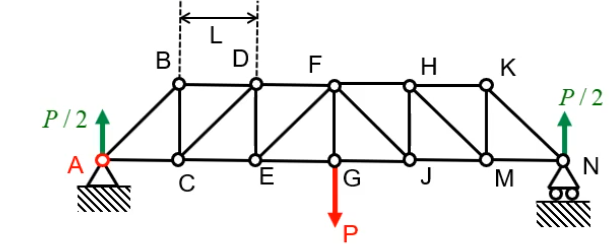

Forces at A
Forces at B
Add the information we just obtained from calculating forces at A:

And draw a free body diagram for the forces at B:
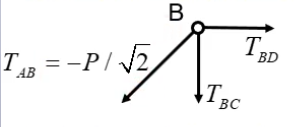
Symmetry in Stuctures
Symmetry of bar forces in a pin jointed frame depends on to aspects:
- Symmetry of the stucture
- Symmetry of the loading (forces applied)
Both conditions must be met to exploit symmetry.
Lecture L1.5, L1.6
Method of Sections
The method of sections is very useful to find a few forces inside a complex structure.
If an entire section is in equilibrium, so are discrete parts of the same structure. This means we an isolate substructures and draws free body diagrams for them.
We must add all the forces acting on the substructure. Then we make a virtua cut through some of the members, replacing them with forces.
Then we can write 3 equilibrium equations for the substructure:
- 1 Horizontal, 1 vertical, and 1 moment equation
- Either horizonal or vertical and 2 moment equations
- 3 moment equations
Example 1
Draw a virtual cut through the structure, making sure to cut through all the bars whose forces you are trying to find:

Draw the free body diagram, substituting cut bars by forces:
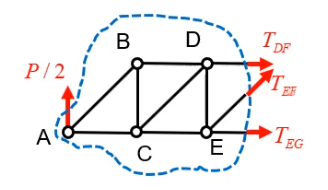
As there are three unknown forces, we need three equilibrium equations.
First Equation: Moments about E
Second Equation: Vertical Equilibrium
Third Equation: Horizontal Equilibrium
Taking Moments from Outside the Structure
If we only needed EG, we could have taken moments about point F, outside our substructure:

Zero-Force Members

Consider the free body diagram for the joint at G:

Meaning that the structure is effecively the same as this one:

Why was it there?
- The structure may be designed for other loading patterns
- The bar may prevent the struture from becoming a mechanism
- A zero force member may also be there to prevent buckling
Externally Applied Moments
Externally applied moments are dealt with in the same way as external forces, but they only contribute to moment equations and not force equilibrium equations.
Distributed Load
A distriuted load is applied uniformly to a bar or section of a bar.
It can be represented by a single force through the midpoint its midpoint.
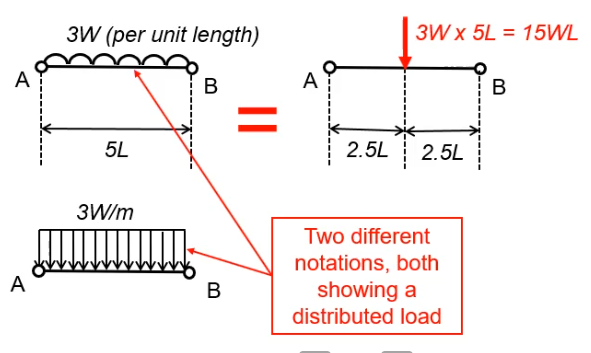
Example 1
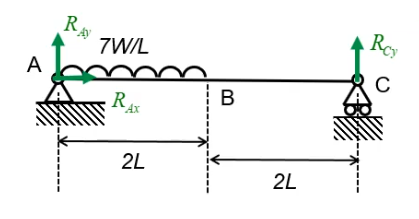
Is equivalent to:

Equivalent Loads
When loads are applied within a bar, as far as support reactions and bar forces in other bars are concered, we can determine equivalent node forces using equilibrium
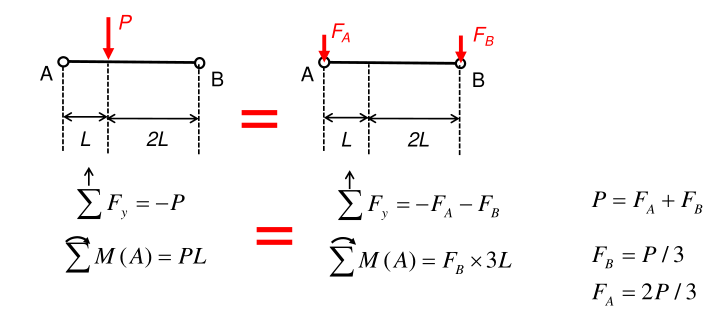
Lecture L1.6
Example 1
The figure shows a light roof truss loaded by a force
kN at 45to the horizontal at point
.
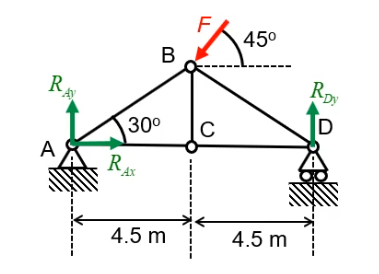
Find the reaction forces at A and D using equilibrium applied to the whole structure.
Add unknown quantities to the diagram

Consider the number of unknowns — there are 3 therefore 3 equations are needed
Decide which equilibrium equation to start with
Horizontal equilibrium:
Vertical equilibrium:
Moment equation:
Solve for
Substitute to find
Use the graphical/trigonometric method o check your answer.
Write the reaction at A as a single force with unknown direction:

When three forces act on an object in equilibrium, they must:
- Make a triangle of forces
- Go through a single point
So we can figure out the angle of by drawing it such that all the lines of action of all forces go through the same point:
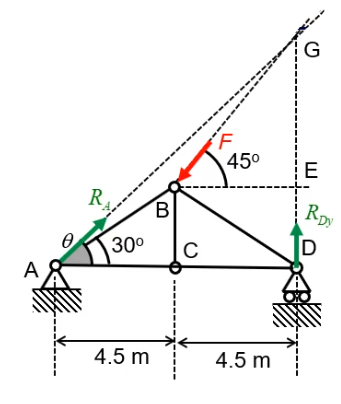
Now draw the force triangle:

Using the sine rule we find out and , which are kN and kN, respectively.
Now we can check our answers in part (a) and (b) are the same:
The methods agree.
Lecture L2.1
Hooke’s Law and Young’s Modulus
Hooke’s law states that the extension of an object experiencing a force is proportonal to the force.
We can generalize this to be more useful creating:
Direct stress:
Direct strain:
Using these more generalized variables, Young defined Young’s Modulus, , which is a universal constant of stiffness of a material.
Example 1
Calculating Young’s Modulus of a Piece of Silicone
Stress Strain Curves

Poisson’s Ratio
For most materials, their cross sectionts change when they are stretched or compressed. This is to keep their volume constant.
Poisson’s ratio, (the greek letter nu, not v), is the ratio of lateral strain to axial strain:
Example 1
Measuring Poisson’s Ratio
It’s supposed to be that but I guess it’s close enough right? lol
Typical Values of Young’s Modulus and Poisson’s Ratio
| Material | Young’s Modulus / GPa | Poisson’s Ratio |
|---|---|---|
| Steel | 210 | 0.29 |
| Aluminum | 69 | 0.34 |
| Concrete | 14 | 0.1 |
| Nylon | 3 | 0.4 |
| Rubber | 0.01 | 0.495 |
Direct Stresses and Shear Stresses

- A direct stress acts normal to the surface
- A shear stress acts tangential to the surface
Shear stress is defined in the same way as direct stress but given the symbol (tau):
Shear strain is defined as the shear angle :
The shear modulus, , is like Young’s Modulus but for shear forces:
Relationship between Young’s Modulus and Shear Modulus
is a good approximation in a lot of engineering cases
page generated by gronk